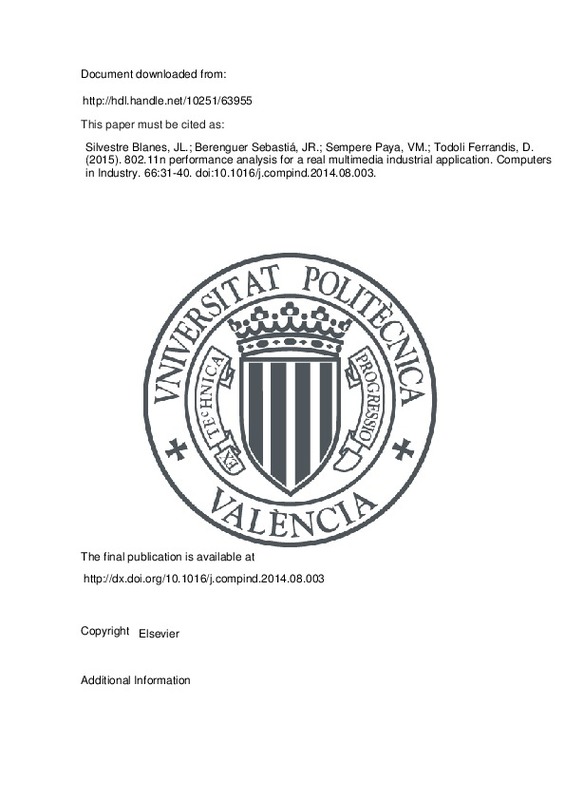JavaScript is disabled for your browser. Some features of this site may not work without it.
Buscar en RiuNet
Listar
Mi cuenta
Estadísticas
Ayuda RiuNet
Admin. UPV
802.11n performance analysis for a real multimedia industrial application
Mostrar el registro sencillo del ítem
Ficheros en el ítem
| dc.contributor.author | Silvestre Blanes, Javier Lidiano
|
es_ES |
| dc.contributor.author | Berenguer Sebastiá, Joaquín Ramón
|
es_ES |
| dc.contributor.author | Sempere Paya, Víctor Miguel
|
es_ES |
| dc.contributor.author | Todoli Ferrandis, David
|
es_ES |
| dc.date.accessioned | 2016-05-12T10:03:16Z | |
| dc.date.available | 2016-05-12T10:03:16Z | |
| dc.date.issued | 2015-01 | |
| dc.identifier.issn | 0166-3615 | |
| dc.identifier.uri | http://hdl.handle.net/10251/63955 | |
| dc.description.abstract | In spite of their limitations, wireless networks are being increasingly used in industrial environments. The electromagnetic phenomena that can occur, along with the interference that may occur due to it being an open medium, mean that fluctuations in latencies are often produced. These drawbacks limit the use of wireless networks for distributed factory applications where timeliness is essential. Recent standards, such as 802.11n, offer some interesting characteristics applicable to factory automation. In particular, QoS support and a very high data rate aids their operation under non-saturation conditions, allowing their satisfactory use as an industrial network. In this paper, the potential of these networks is analyzed in a real world scenario and their performance is compared with an idealized scenario. In both cases the priorities behave as expected, however, the algorithms for an auto-rate functioning perform badly in real world situations, especially in industrial scenarios such as those analyzed here, where the mobility of sources and the interference produced by other sources produce frequent rate changes, leading to a reduction in network performance. (C) 2014 Elsevier B.V. All rights reserved. | es_ES |
| dc.description.sponsorship | This work is supported by the MCYT of Spain under the project TIN2013-47272-C2-1-R. | en_EN |
| dc.language | Inglés | es_ES |
| dc.publisher | Elsevier | es_ES |
| dc.relation.ispartof | Computers in Industry | es_ES |
| dc.rights | Reserva de todos los derechos | es_ES |
| dc.subject | Wireless network | es_ES |
| dc.subject | Fieldbuses | es_ES |
| dc.subject | Image processing | es_ES |
| dc.title | 802.11n performance analysis for a real multimedia industrial application | es_ES |
| dc.type | Artículo | es_ES |
| dc.identifier.doi | 10.1016/j.compind.2014.08.003 | |
| dc.relation.projectID | info:eu-repo/grantAgreement/MINECO//TIN2013-47272-C2-1-R/ES/PLATAFORMA DE SERVICIOS PARA CIUDADES INTELIGENTES CON REDES M2M DENSAS/ | es_ES |
| dc.rights.accessRights | Abierto | es_ES |
| dc.contributor.affiliation | Universitat Politècnica de València. Instituto Universitario Mixto Tecnológico de Informática - Institut Universitari Mixt Tecnològic d'Informàtica | es_ES |
| dc.description.bibliographicCitation | Silvestre Blanes, JL.; Berenguer Sebastiá, JR.; Sempere Paya, VM.; Todoli Ferrandis, D. (2015). 802.11n performance analysis for a real multimedia industrial application. Computers in Industry. 66:31-40. https://doi.org/10.1016/j.compind.2014.08.003 | es_ES |
| dc.description.accrualMethod | S | es_ES |
| dc.relation.publisherversion | http://dx.doi.org/10.1016/j.compind.2014.08.003 | es_ES |
| dc.description.upvformatpinicio | 31 | es_ES |
| dc.description.upvformatpfin | 40 | es_ES |
| dc.type.version | info:eu-repo/semantics/publishedVersion | es_ES |
| dc.description.volume | 66 | es_ES |
| dc.relation.senia | 277742 | es_ES |
| dc.identifier.eissn | 1872-6194 | |
| dc.contributor.funder | Ministerio de Economía y Competitividad | es_ES |







![[Cerrado]](/themes/UPV/images/candado.png)

